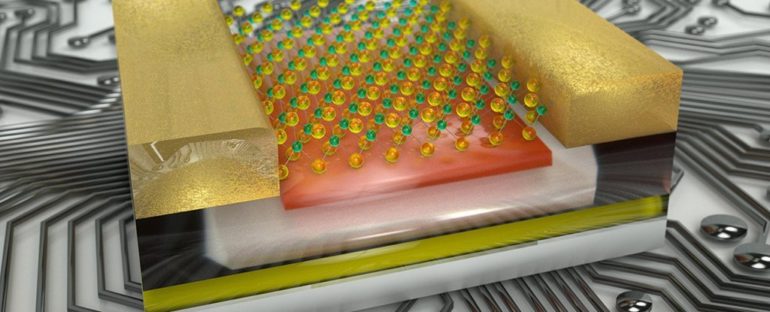Traditional computer chips use separate areas for calculations and data storage, but new research has shown how these areas can be combined together on a 2D material for the first time – which should lead to smaller, more powerful, more energy-efficient devices.
It’s technically known as a logic-in-memory architecture or a single architecture, where logic operations are combined with memory functions. It saves the time and energy needed to pass data between the processing and the storage stages.
And while these single architecture chips have been developed before, they haven’t used a 2D material – in this case, molybdenum disulphide or MoS2. An excellent semiconductor just three atoms thick, MoS2 has proved to be an ideal material for the job.
(EPFL/LANES)
The scientists behind the innovation say it could be particularly useful in artificial intelligence, from self-driving cars to smart speakers that can recognise your voice, because it mimics the sort of joined-up approach that human brain neurons use.
“This ability for circuits to perform two functions is similar to how the human brain works, where neurons are involved in both storing memories and conducting mental calculations,” says electrical engineer Andras Kis, from the Swiss Federal Institute of Technology (EPFL) in Lausanne.
“Our circuit design has several advantages. It can reduce the energy loss associated with transferring data between memory units and processors, cut the amount of time needed for computing operations, and shrink the amount of space required.”
The new chip is based on floating-gate field-effect transistors, or FGFETs. Already used for storage inside phones and laptops, these transistors are known for being able to hold electrical charges for long periods.
Having been previously established as a brilliant material for electronics, MoS2 is sensitive enough to work in tandem with the FGFETs to pack numerous processing functions inside single circuits, enabling these circuits to work as both memory storage units and programmable transistors.
As usual with this sort of lab work, it’s going to take a while to convert it into a form suitable for commercial systems and gadgets, but the team behind the research has the necessary expertise in terms of scaling up chip production technologies.
More and more of our gadgets, from security cameras to street signs, need extra smarts – not just to store information but to process it and make intelligent decisions along the way, all while keeping power demands low.
Meeting that demand involves not just figuring out the physics of the necessary computer chips but also finding the right materials to make them a reality, as the researchers have done here. And it turns out that copying the human brain is a pretty good approach when it comes to AI.
“This direct integration of memory and logic can increase processing speed, opening the way to the realisation of energy-efficient circuits based on 2D materials for machine learning, the Internet of Things and non-volatile computing,” write the researchers in their published paper.
The research has been published in Nature.



